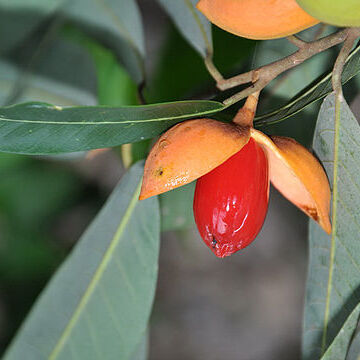Tree 5-20 m. Twigs l-2(-2.5) mm in diameter, at first with yellowish brown hairs 0.1-0.3 mm long, glabrescent; bark striate, not or but rarely tending to crack, never flaking. Leaves membranous or thinly coriaceous, at first with indumentum mainly of stellate golden brown or grey hairs 0.1 mm long, early or late glabrescent, oblong to lanceolate, parallel-sided or broadest at or below the middle, 6-18(-24) by 1.5-4(-7) cm, apex acute or acuminate, base attenuate, rarely rounded; olivaceous to dark brown, usually with a blackish metallic lustre above; lower surface greyish, finely papillate (lens!); dots absent; midrib sunken above; nerves 10-18(-22) pairs, faint, flat or sunken above; venation inconspicuous; petiole 7-13 by 1—1.5(—3) mm. Inflorescences: sessile or peduncle 1-5 mm, brachyblast simple or bifurcate, to 10 mm long; in male 5-20-flow-ered, in female 1-10-flowered; flowers with persistent, rusty, ± woolly hairs (0.05-) 0.1-0.3(-0.7) mm long, perianth 3-(or 4-)lobed, creamy or reddish (?) inside. Male flowers: pedicel 3-5 mm long (outside Malesia to 11 mm long), bracteole above halfway (in Malesia often apically), caducous or persistent; buds subglobose to broadly obovoid, often triangular in the basal part, 3-5 mm in diameter, cleft c. 2/3, lobes 0.3-0.6 mm thick; staminal disc circular or angled, flat, 1.5-2.5 mm in diameter; anthers 8—13(—16), subsessile or just stiped, horizontal, 0.3-0.7 mm, not touching; androphore 0.5-1 mm long. Female flowers: pedicel 1.5-4 mm long, bracteole (nearly) apical; buds ellipsoid-urceolate to ovoid, 4-5 by 2.5-3.5 mm, cleft about halfway; ovary subglobose or conical, 1.5-2 mm long; style 0.5-1 mm long, stigma ± flat, ± 2-lobed and each lobe again (2-)3-7-lobulate. Fruits 1-5 per infructescence, ellipsoid, subglobose, or sometimes ± pear-shaped, 1.2-2 by 1-1.5 cm, at first with grey-brown to rusty hairs 0.1-0.2 mm long, ± glabrescent, dry pericarp 2 mm thick; fruiting pedicel 3-10 mm long.
More
Trees to 15 m tall, 10-25 cm d.b.h.; bark grayish brown, ± flaking; branches spreading or slightly drooping, juvenile branches with pubescence of short stellate hairs ca. 0.5 mm or less, glabrescent, tawny or black. Petioles 8-15 mm, glabrescent; leaf blade oblong to lanceolate, 10-20(-24) × 2-4(-7) cm, abaxially pallid, adaxially lucid, papery, glabrous, sometimes along veins with nearly scurfy pubescence, base broadly cuneate to ± rounded, apex acute or acuminate; lateral veins 12-20 pairs. Male flowers (2-)6-9, tufted on tubercular peduncles 3-8 mm; pedicel 4-11 mm; buds globose, 3-5 mm in diam., with hairs 0.2-0.5 mm; perianth lobes 3; bracteole inserted halfway or higher on pedicel; anthers 10-16, sessile. Female inflorescences 0.5-1 cm. Female flowers ovoid-oblong, ca. 4 mm; pedicel 2-4 mm; bracteole subapical; style ca. 1.5 mm. Fruiting pedicel 3-10 mm. Fruits 1-5, ellipsoid, 1.5-2(-2.5) × 1-1.5 cm, with hairs ca. 0.5 mm or less, glabrescent, at base often with persistent perianth; pericarp 1-2 mm thick. Aril red, enclosing seed or at apex slightly open. Fl. Dec-Mar of next year and fr. Jul-Sep at low altitude, fl. and fr. Jul-Sep at high altitude.
A tree. It grows 15 m tall. The trunks is 10-25 cm across. The bark if grey brown and flaking. Young branches are hairy. The leaves are oval to sword shaped and 10-20 cm long by 2-4 cm wide. They are pale underneath. Male and female flowers are separate. Fruit occur as 1-5 in a group and are narrowly oval. They are 2 cm long by 1 cm wide. They have a red aril covering the seed.


